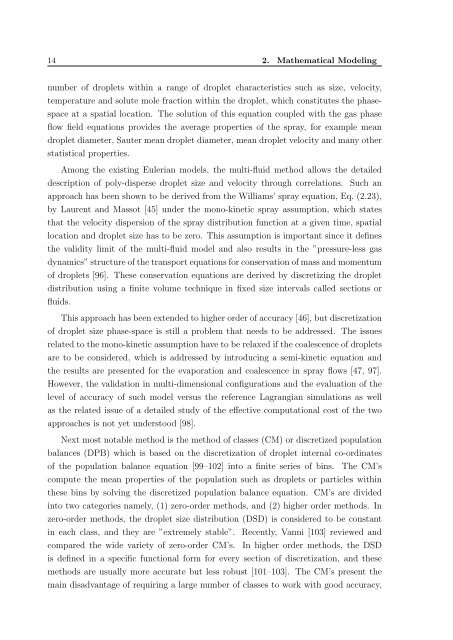INAUGURAL–DISSERTATION zur Erlangung der Doktorwürde der ...
INAUGURAL–DISSERTATION zur Erlangung der Doktorwürde der ...
INAUGURAL–DISSERTATION zur Erlangung der Doktorwürde der ...
Create successful ePaper yourself
Turn your PDF publications into a flip-book with our unique Google optimized e-Paper software.
14 2. Mathematical Modeling<br />
number of droplets within a range of droplet characteristics such as size, velocity,<br />
temperature and solute mole fraction within the droplet, which constitutes the phasespace<br />
at a spatial location. The solution of this equation coupled with the gas phase<br />
flow field equations provides the average properties of the spray, for example mean<br />
droplet diameter, Sauter mean droplet diameter, mean droplet velocity and many other<br />
statistical properties.<br />
Among the existing Eulerian models, the multi-fluid method allows the detailed<br />
description of poly-disperse droplet size and velocity through correlations. Such an<br />
approach has been shown to be <strong>der</strong>ived from the Williams’ spray equation, Eq. (2.23),<br />
by Laurent and Massot [45] un<strong>der</strong> the mono-kinetic spray assumption, which states<br />
that the velocity dispersion of the spray distribution function at a given time, spatial<br />
location and droplet size has to be zero. This assumption is important since it defines<br />
the validity limit of the multi-fluid model and also results in the ”pressure-less gas<br />
dynamics” structure of the transport equations for conservation of mass and momentum<br />
of droplets [96]. These conservation equations are <strong>der</strong>ived by discretizing the droplet<br />
distribution using a finite volume technique in fixed size intervals called sections or<br />
fluids.<br />
This approach has been extended to higher or<strong>der</strong> of accuracy [46], but discretization<br />
of droplet size phase-space is still a problem that needs to be addressed. The issues<br />
related to the mono-kinetic assumption have to be relaxed if the coalescence of droplets<br />
are to be consi<strong>der</strong>ed, which is addressed by introducing a semi-kinetic equation and<br />
the results are presented for the evaporation and coalescence in spray flows [47, 97].<br />
However, the validation in multi-dimensional configurations and the evaluation of the<br />
level of accuracy of such model versus the reference Lagrangian simulations as well<br />
as the related issue of a detailed study of the effective computational cost of the two<br />
approaches is not yet un<strong>der</strong>stood [98].<br />
Next most notable method is the method of classes (CM) or discretized population<br />
balances (DPB) which is based on the discretization of droplet internal co-ordinates<br />
of the population balance equation [99–102] into a finite series of bins. The CM’s<br />
compute the mean properties of the population such as droplets or particles within<br />
these bins by solving the discretized population balance equation. CM’s are divided<br />
into two categories namely, (1) zero-or<strong>der</strong> methods, and (2) higher or<strong>der</strong> methods. In<br />
zero-or<strong>der</strong> methods, the droplet size distribution (DSD) is consi<strong>der</strong>ed to be constant<br />
in each class, and they are ”extremely stable”. Recently, Vanni [103] reviewed and<br />
compared the wide variety of zero-or<strong>der</strong> CM’s. In higher or<strong>der</strong> methods, the DSD<br />
is defined in a specific functional form for every section of discretization, and these<br />
methods are usually more accurate but less robust [101–103]. The CM’s present the<br />
main disadvantage of requiring a large number of classes to work with good accuracy,













